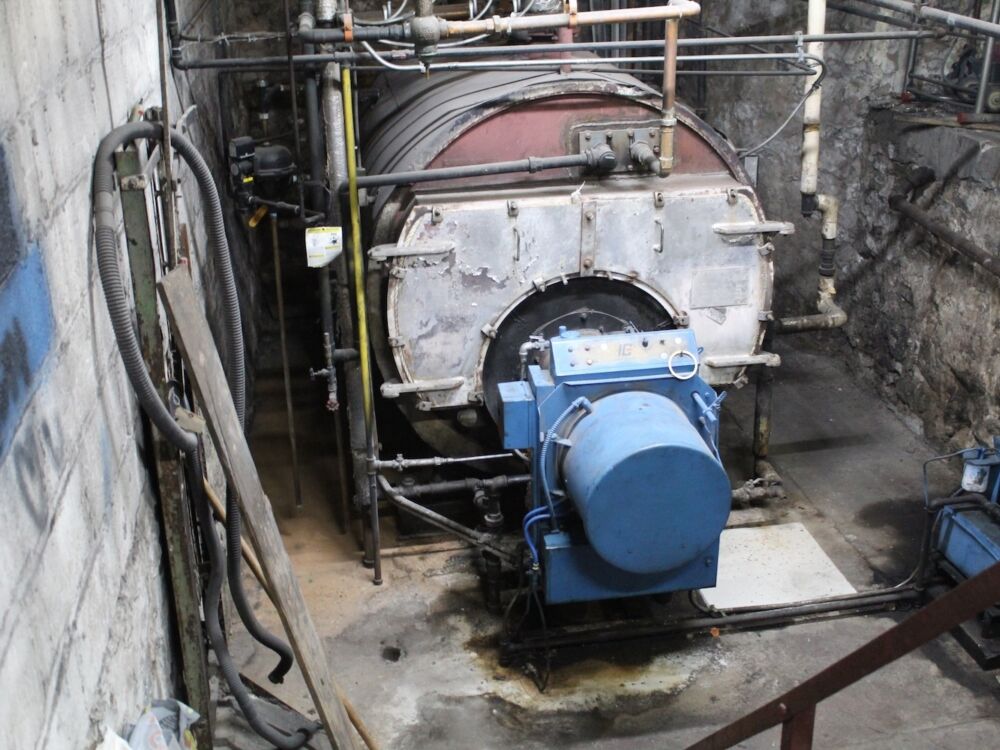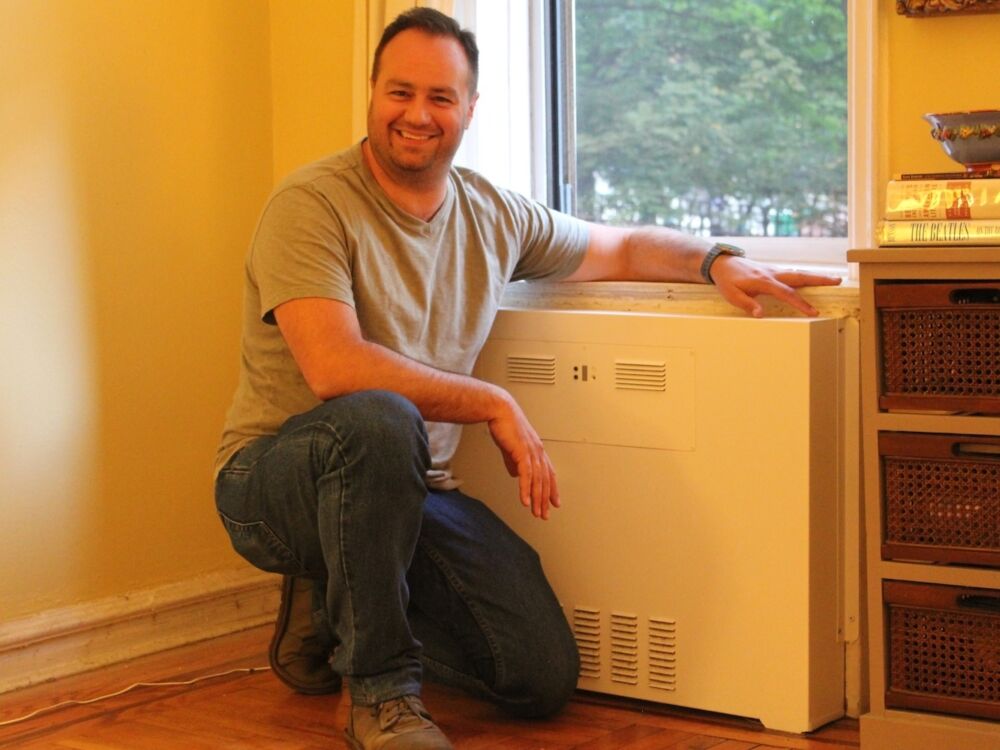
A ConEd asphalt tag marks a street near Inwood Park Apartments, indicating that the utility has done underground construction work. Photo: Ayana Smith
A $3 million quote for infrastructure upgrades from Con Edison sent the Inwood Park Apartments co-op searching for another solution
As New York City pushes large buildings to cut their carbon emissions, some homeowners are learning firsthand that the road away from fuel oil can be paved with formidable challenges. Inwood Park Apartments, a 50-unit building perched at the top of Manhattan, discovered this the hard way when residents learned that their modest plans for a boiler fuel upgrade could cost them millions of dollars.
The middle-income cooperative, built in 1937, is subject to Local Law 97 (LL97), along with many other aging buildings, and could have begun facing fines soon if they didn’t take action. Fortunately, co-op board president Hal Fuchsman said the building’s manager put LL97 on their radar early, “before it was even something that most people talked about.”
They wanted to get out ahead, so several years ago they started exploring possible retrofit solutions that could help bring down the building’s overall carbon emissions. But they kept hitting roadblocks.
The Challenge
Take, for example, the roof. “The roof was designed to hold two things: The roof, and snow,” said Fuchsman. Many residents pushed for solar panels, but they were disappointed to learn that their roof likely wouldn’t bear the load without reinforcing the wooden beams that held it up.
The solution to replace the wooden beams, Fuchsman said, would have been to “helicopter up steel.” After recently spending almost a million dollars to re-do the roof’s surface, starting over felt out of the question.
Down below, there’s the bedrock. Inwood Park Apartments is located at 585 W. 215th St., and has no basement; like many buildings in the area, it’s built right into the city’s sloping schist. That eliminated another climate friendly option: A geothermal heat pump, which uses the near-constant temperature underground to absorb warm or cold air from above.
Instead, the building opted to work with its existing boiler. The No. 4 fuel oil they use is a step up from the coal that originally powered the building. But as LL97 fines kick in and ramp up over the coming years, the boiler is becoming a liability. Just upgrading their No. 4 fuel oil to No. 2, which will be required anyway under another local law, would add costs without bringing any meaningful efficiencies.
The Roadmap: Plan A
In 2021, wanting to understand the options at their disposal, Inwood Park Apartments contracted with Bright Power for an energy audit.
Darren Johnson, the Bright Power account manager who worked on the project, said the consulting group often helps buildings optimize what they have, with a focus on projects that pay for themselves through added energy efficiency.
“A lot of times, especially if it’s an inefficient building on oil, a lot of the upgrades are going to look financially good, because oil is expensive,” said Johnson. For Inwood Park Apartments, the recommendation was clear: Skip fuel oil No. 2, and switch to natural gas.
Natural gas could make use of the building’s existing steam radiator system, while being more energy efficient than fuel oil. Modern controls for the boiler and usage monitoring would bring costs further down. All told, Bright Power estimated a project cost around $200,000 for the boiler upgrades.
Excited for a solution, the building partnered with a firm called Metro Group to estimate how much gas they would need and how much it would cost.
Metro Group gave a ballpark estimate of $10,000 for a gas line hookup from energy company Con Edison, and submitted a load letter to the utility asking for a quote. In response, ConEd quoted them $3 million.
“When ConEd returns a $3 million bill, that’s ConEd speak for saying you don’t get gas,” Fuchsman said. “It’s totally unrealistic.”
With that blow, Fuchsman and his fellow shareholders smacked headlong into another set of challenges: What to do when your building’s needs run counter to larger plans that weren’t designed with you in mind.

The Inwood Park Apartments boiler is built directly on top of bedrock that lies beneath the neighborhood. Photo: Ayana Smith
The Roadblock: A City Transitioning Away from Gas
Fuchsman and Johnson say that the explanation for the sky-high gas quote is that their project was caught up in larger changes happening around them: ConEd had already been in the process of switching other large Inwood buildings from low to high pressure gas lines.
Either line type could have powered the Inwood Park Apartments, but the utility said a brand-new high pressure line would be needed for the project. Fuchsman and Johnson assume that other projects maxed out the existing low-pressure lines.
“When you have a lot of buildings that all start to convert — and that’s what happened in their neighborhood — then they [can take] up that extra capacity,” Johnson said. The high price tag was for extending a high-pressure line from further away, and Johnson said ConEd passes those costs for the major infrastructure construction on to buildings when needs do not align with existing plans.
While the cost wasn’t typical, Johnson said, “it’s not the only one we’ve seen.” He remembers another Bright Power client on the East side who saw a $2.7 million gas hookup charge.
In a statement to Skylight, a spokesperson from ConEd confirmed, “The cost estimate provided would have covered the work needed to bring in natural gas from a different main, the closest of which is nearly half a mile away.”
The spokesperson said that the company would have covered the first 100 feet of main for the building, but that any work beyond that would have to be paid for by the Inwood Park Apartments residents, and not “passed along to other customers.”
Or, as Johnson put it, “You’re gonna have to pay for it — or you can wait until we get to you.” But it’s hard to tell how long that wait might be, since the utility’s timelines for specific projects are not public.
Back to the Roadmap: Building Plan B
So, unable to pay for a new line, the building went back to the drawing board.
Initially, Bright Power had recommended pairing gas with other smaller tweaks to improve the performance of their boiler: A timer to shut off the boiler when not needed, and a “radiator Cozy” system to control supply and monitor usage.
The radiator Cozys, from a company called Kelvin, save energy by keeping over-enthusiastic radiators in check. They provide insulation, trapping warm air around the radiator, monitoring the room temperature, and releasing hot air only as needed. This prevents apartments from becoming sweltering saunas, saving energy in the process. The thermometers included in the Cozys also connect to the central boiler downstairs, making it turn on and off with more precision.
In the initial plan, a ConEd incentive program, MFEEP, would have offered around $40,000 towards the devices. But that program was only available to buildings that had already switched to gas, Fuchsman said.
Still, the building decided to go ahead and add the Cozys and timer, paying a bit less than $150,000 for them out of pocket.
As it turns out, many residents preferred their saunas. The radiator Cozy solution essentially forced the whole building to turn down the heat. To meet fuel reduction goals, shareholders found themselves reaching for sweaters.
“Half the building’s pissed cause they’re too cold,” said Fuchsman. “And I’m pissed because this is all I talk about now.”
Still, from an energy efficiency perspective, Plan B is working. Between the Cozy system, the boiler timer, and a couple of milder winters, Fuchsman said, “We’ve saved about 20 percent on fuel oil.”
Those savings are in the same ballpark as Bright Power’s estimates for a natural gas conversion, although Plan A might have yielded warmer apartments. Using less fuel oil saved money, but it also reduced greenhouse gas emissions by 27 percent, eliminating roughly 70 tons of CO2 emissions per year. As a result, the building has hit its LL97 compliance target for 2025.
“We would have spent the amount of money we spent on Cozys in penalties pretty quickly, so I’m glad we did something. I’m glad we’re putting the right food forward,” Fuchsman said.
Still, the process with all of its disappointments, has not been good for morale, he said. From residents’ perspective, reducing emissions for now still means turning down the heat. “It’s all stick and no carrots,” Fuchsman said. “This is what it looks like. You can’t have it both ways.”
And for LL97 compliance, reducing fuel oil use is still only an intermediate step. Because energy efficiency expectations tighten over time, without further changes, the building will likely have to start paying yearly fines beginning in 2031.

Inwood Park Apartments board president Hal Fuchsman has warmed up to the radiator Cozys that have reduced his building’s carbon emissions and energy spending. Others aren’t so keen. Photo: Ayana Smith
Preparing For the Future
Inwood Park Apartments’ expensive natural gas quote is an early example of a larger trend that other buildings are likely to experience as lawmakers plan to incentivize conversions to electric rather than gas.
This summer, New York state legislators passed a bill that, if signed by the governor, could make higher gas hookup charges more common. For buildings near existing lines, gas hookup costs have traditionally been socialized across gas customers. The proposed law would put connection costs on the buildings requesting them.
The Natural Resource Defense Council called the bill “a meaningful step toward fairness and affordability, ending the practice of forcing all ratepayers to subsidize fossil fuel infrastructure for new customers.”
The NRDC advocates for transitioning to renewable fuels for the building sector in order to reduce climate-warming fossil fuel emissions. So does the Mayor’s Office.
“By leapfrogging oil-to-gas conversions, building owners can future-proof their assets, comply with LL97, and insulate themselves from fluctuating fossil fuel prices,” a spokesperson for the Mayor’s Office of Climate & Environmental Justice told Skylight. “This ends subsidies to buildings for gas hookups and incentivizes buildings to switch to efficient electric heating and hot water systems.”
But this can be a big jump for older buildings to make all at once — and sometimes, not a financially feasible one.
Johnson said he believes that currently, there is not enough money in the financing ecosystem to help low- and moderate-income building owners decarbonize. Many buildings still need more financial support, Johnson said, to make the switch — even though city, state, and utility level programs all offer additional financial incentives. (For example, based on the latest data available, Inwood Park Apartments is not eligible for the citywide J‑51 tax abatement for energy efficiency retrofits and electrification projects.)
In this co-op’s case, making gas unworkable was not enough to incentivize electrification. Using Fuchsman’s current back-of-envelope math, electrifying is not obviously cheaper than paying a $3 million hookup charge because of all of the costs it would entail, including removing the boiler, decommissioning the fuel-oil tank, and updating the building envelope and electrical panels — all before the cost of heat pump equipment.
And there are other costs to consider in addition to the financial. Installing in-unit heat pumps, for instance, would require the co-op to pass new bylaws; right now, in-unit upgrades are the individual responsibility of each owner, and can’t be mandated.
“That’s the co-op equivalent of a constitutional amendment,” Fuchsman said. Because in-unit work is currently individualized, it makes collective action difficult, especially since not all shareholders can afford the same solutions.
The Mayor’s office agreed that “in some cases, full electrification is not a viable strategy unless implemented over time, in alignment with capital cycles, equipment end-of-life, tenant turnover, and other key milestones,” though the city “continues to advocate for financial resources at the state and federal level.”
In the meantime, the office’s spokesperson recommended that buildings work with the NYC Accelerator on long-term decarbonization plans.
Johnson agreed that it pays to keep thinking ahead. Strategies will differ from building to building, he said, but “sitting on their hands is never going to be the right answer.”
Both Johnson and Fuchsman hope that changes to technology, financing, and the regulatory pathways to become more inclusive could eventually smooth the process.
For Inwood Park Apartments, delaying action means continuing to rely on a boiler already past the end of its useful life. But for now, Fuchsman is reframing. He is modeling the future costs they may face come 2031, and imagining LL97 fines not as a penalty, but as yet another tax to share among shareholders.
“We just have to think about it as a line item, right now, absent any major advancements,” Fuchsman said. “We have to be realistic about what we can do without making it unaffordable to live here.”
